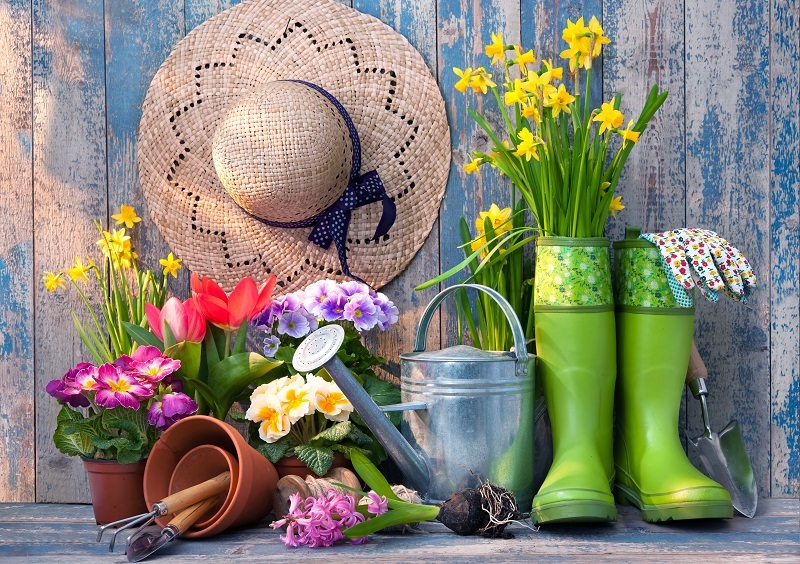Unveiling Your Birth Flower and Its Hidden Secrets
Posted on 18/08/2025
Unveiling Your Birth Flower and Its Hidden Secrets
Have you ever wondered if there's a floral symbol tied to the month you were born? Your birth flower isn't just a beautiful plant -- it's a living emblem brimming with history, symbolism, and fascinating stories. In this comprehensive article, we'll unveil your birth flower, exploring its hidden secrets, meanings, and how it influences your personality. Whether you're a fan of blossoming botanicals or simply searching for an unusual way to deepen your self-knowledge, discovering your birth flower can be a delightfully insightful journey.

What Is a Birth Flower?
Much like birthstones, birth flowers are associated with each month of the year. This tradition dates back centuries, with roots in Roman, Victorian, and even Ancient Greek cultures. Each birth flower has its unique charm, reflecting qualities, colors, and hidden meanings that are as individual as the people they represent.
Birth flowers were historically given as meaningful gifts, often used to convey messages when words felt inadequate. Today, this tradition lives on, with many people choosing to incorporate their birth flower into celebrations, self-expression, and even personal growth journeys.
The Complete List: Birth Flowers by Month
Before we unravel the hidden secrets of birth flowers, let's discover which flower matches your birth month:
- January: Carnation and Snowdrop
- February: Violet and Primrose
- March: Daffodil and Jonquil
- April: Daisy and Sweet Pea
- May: Lily of the Valley and Hawthorn
- June: Rose and Honeysuckle
- July: Larkspur and Water Lily
- August: Gladiolus and Poppy
- September: Aster and Morning Glory
- October: Marigold and Cosmos
- November: Chrysanthemum
- December: Narcissus and Holly
The Symbolism and Hidden Secrets of Each Birth Flower
January: Carnation and Snowdrop
Carnation: Known as the "flower of the gods," carnations symbolize love, fascination, and distinction. The various shades carry subtle messages -- red for deep love, pink for gratitude, and white for pure affection. If your birthday falls in January, you're likely resilient and compassionate, always bringing warmth to winter's chill.
Snowdrop: These delicate blooms are among the first to appear after the frost, and thus represent hope, rebirth, and innocence. People born under the snowdrop's sign tend to be optimistic and strong-willed, unafraid to blossom in the coldest conditions.
February: Violet and Primrose
Violet: Violets symbolize modesty, humility, and spiritual wisdom. In Victorian times, giving violets meant "I'll always be true." February babies often possess quiet strength, artistic flair, and a noble heart.
Primrose: This cheerful flower stands for youth, new beginnings, and undying love. Primrose's symbolism hints at innocence, making it perfect for those with a gentle, nurturing spirit.
March: Daffodil and Jonquil
Daffodil: Among the first harbingers of spring, daffodils represent renewal, hope, and joy. Born in March? You're likely optimistic, friendly, and the life of every gathering.
Jonquil: Closely associated with affection and desire for connection, jonquils invite happiness and confidence wherever they bloom.
April: Daisy and Sweet Pea
Daisy: With its bright, cheerful petals, the daisy symbolizes innocence, purity, and loyal love. April-born individuals often exude positivity and bring light to every room.
Sweet Pea: Representing delicate pleasure and goodbyes, sweet peas indicate gratitude. If April is your month, you're probably sincere and sensitive, cherished by many.
May: Lily of the Valley and Hawthorn
Lily of the Valley: These tiny, bell-shaped blooms stand for humility, sweetness, and a return to happiness. May babies are often gentle souls with optimistic outlooks.
Hawthorn: Signifying hope and supreme happiness, hawthorn flowers bring a sense of security and promise.
June: Rose and Honeysuckle
Rose: Arguably the most famous flower, the rose's symbolism is vast--passionate love, admiration, friendship, and more. The color of the rose further refines its meaning. June-borns are romantic and charismatic, with a natural ability for deep connections.
Honeysuckle: This flower represents the bonds of love and devoted affection. If you're a June baby, you're likely to value loyalty and heartfelt relationships.
July: Larkspur and Water Lily
Larkspur: Symbolizing openheartedness, positivity, and lightness, larkspurs reflect July's summer spirit. These individuals are often creative, enthusiastic, and compassionate.
Water Lily: Water lilies represent enlightenment and purity of heart. If you're born under this sign, you may possess a wise and tranquil nature.
August: Gladiolus and Poppy
Gladiolus: Named for their sword-like leaves, gladiolus flowers symbolize strength, moral integrity, and infatuation. August babies stand tall and courageous, inspiring others with their conviction.
Poppy: Known for vibrant hues, poppies represent imagination, remembrance, and peace.
September: Aster and Morning Glory
Aster: With a name meaning 'star', asters symbolize patience, wisdom, and elegance. If you're a September-born, you're likely meticulous, thoughtful, and cherished for your loyalty.
Morning Glory: These flowers open at sunrise, symbolizing affection and the fleetingness of love.
October: Marigold and Cosmos
Marigold: With their fiery colors, marigolds signify creativity, passion, and inner strength. October individuals are energetic and inspiring, unafraid to chase their dreams.
Cosmos: Symbolizing order, peace, and harmony, cosmos flowers reflect a balanced and diplomatic nature.
November: Chrysanthemum
Chrysanthemum: These regal blooms symbolize friendship, joy, and loyalty. November-born folks are sincere and steadfast, valued by friends for their wisdom and generosity.
December: Narcissus and Holly
Narcissus: Reflecting hope, good wishes, and rebirth, narcissus brings cheer to cold days. December babies are ambitious, with a knack for inspiring those around them.
Holly: Symbolizing protection and domestic happiness, holly celebrates family and tradition during the festive season.
The Secret Powers and Hidden Meanings of Birth Flowers
What makes your birth flower even more fascinating is the deep symbolism and folklore woven into each petal. For centuries, flowers were given as silent messages--a language called "Floriography." Here's how the hidden secrets of your birth flower could reveal more about your personality, relationships, and life path:
- Strengths and Personality: Many believe your birth flower embodies key strengths and personality traits. For example, roses (June) signify warmth and passion, while daffodils (March) suggest optimism and creativity.
- Floromancy (Flower Divination): In some cultures, birth flowers are used for guidance, much like zodiac signs. Drawing a flower card or meditating with your birth flower can offer insight into upcoming opportunities or challenges.
- Love and Relationships: Presenting someone with their birth flower is thought to bring good fortune, deepen bonds, or even spark romance.
- Health and Well-being: Certain birth flowers, such as chamomile (sometimes associated with May), have been used in herbal medicine for centuries to promote wellness.
- Life Events and Talismans: Carrying or growing your birth flower is seen in some traditions as a charm for luck and protection.
How to Use and Celebrate Your Birth Flower
There are countless joyful ways to honor your birth flower, bringing its subtle energy into your daily life. Here are a few creative ideas:
- Gardening: Grow your birth flower in your home or garden as a unique way of connecting with your roots and promoting mindfulness.
- Gift Giving: Surprise a friend or loved one with a bouquet featuring their birth month flower.
- Artistic Inspiration: Incorporate the imagery of your birth flower into art, jewelry, or home decor for a personalized touch.
- Mindful Reflection: Meditate with your birth flower in mind, focusing on its symbolism and how it relates to your life journey.
- Celebrations: Feature your birth flower at birthday parties, weddings, or special events to add a layer of meaning and beauty.
Your Birth Flower and the Zodiac
Did you know that your birth month flower can also align with your astrological sign? Astrologers believe certain flowers harmonize especially well with zodiac traits, enhancing your strengths and supporting your journey. Here are a few combinations:
- Aries (March-April): Daffodil & Daisy -- Bold, energetic, and optimistic.
- Taurus (April-May): Lily of the Valley & Hawthorn -- Grounded, dependable, and nurturing.
- Gemini (May-June): Rose -- Adaptable, witty, and sociable.
- Cancer (June-July): Honeysuckle & Larkspur -- Intuitive, heartfelt, and loyal.
- Leo (July-August): Gladiolus -- Vibrant, courageous, and inspiring.
- Virgo (August-September): Aster -- Pragmatic, wise, and detail-oriented.
- Libra (September-October): Cosmos -- Diplomatic, balanced, and creative.
- Scorpio (October-November): Chrysanthemum -- Mysterious, passionate, and steadfast.
- Sagittarius (November-December): Narcissus -- Adventurous and insightful.
- Capricorn (December-January): Carnation -- Reliable, ambitious, and disciplined.
- Aquarius (January-February): Violet -- Innovative, wise, and humanitarian.
- Pisces (February-March): Jonquil -- Dreamy, compassionate, and creative.
Birth Flowers Around the World: A Cultural Perspective
Every culture has its own interpretation of the birth flower tradition. In Japan, Hanakotoba--the language of flowers--designates different meanings still widely celebrated in modern times. Similarly, Native American tribes, the Victorians, and the Ancient Greeks all used birth flowers to mark ceremonies, send messages, or commemorate life's big moments.
Examples:
- Japan: Cherry blossoms evoke both the beauty and impermanence of life--an idea deeply embedded in Japanese culture.
- Victorian England: Every conceivable emotion could be conveyed with bouquets, from secret love to forgiveness.
- Ancient Greece: Flowers were closely associated with the gods, and offering particular blooms was thought to invoke divine favor.
How to Discover and Connect with Your Birth Flower
- Identify Your Birth Flower: Use the chart above or consult with local florists or historical resources for precise regional variations.
- Research Its History: Explore the legends, medicinal uses, and traditional symbolism attached to your birth flower.
- Grow or Display: Bring your flower into your space through gardening, fresh bouquets, or potted plants.
- Embrace Its Lessons: Reflect on the qualities your birth flower embodies--strength, love, hope--and consider how these resonate with your personal journey.
- Share Its Meaning: Celebrate special occasions or honor loved ones with stories or gifts tied to their birth month flower.

Fun Facts and Fascinating Trivia About Birth Flowers
- Carnations were once worn as badges by members of ancient Greek societies to show their loyalty and status.
- The daffodil is the national flower of Wales and is often worn on St. David's Day.
- Romans believed roses would bring protection and rejuvenate the spirit, often adorning homes with fresh blooms during celebrations.
- Ancient Egyptians used water lilies as garlands in sacred rituals.
- Victorians often used marigolds to symbolize despair--today, they're a sign of hope and celebration.
Final Thoughts: Embrace Your Birth Flower and Its Secret Wisdom
Unveiling your birth flower is a rewarding journey into the world of nature, timeless tradition, and self-discovery. Whether you plant it, wear it, or simply admire its beauty, your flower can offer comfort, inspiration, and a deeper sense of connection to who you are. Next time you celebrate a birthday--or seek to understand a loved one better--consider the secret language in every petal and the unique story each birth flower tells.
Let the hidden secrets of your birth flower reveal themselves, and blossom into new perspectives on life!
Latest Posts
Unveiling Your Birth Flower and Its Hidden Secrets
Exploring the significance of birth month flowers
Explore the Top 5 Flowers to Gift on Valentine's Day





